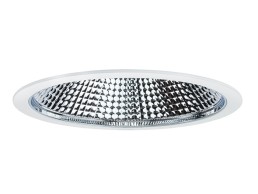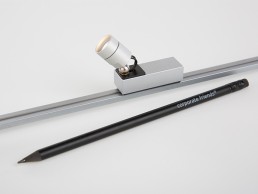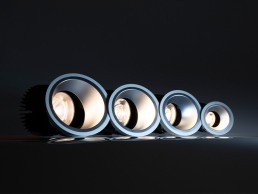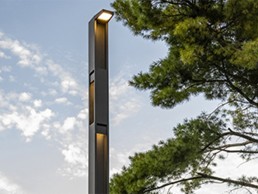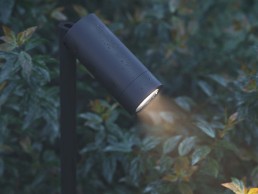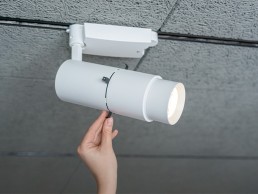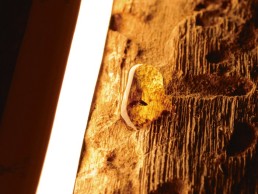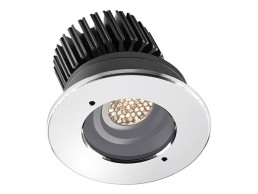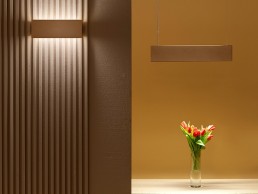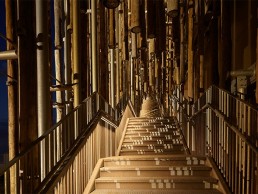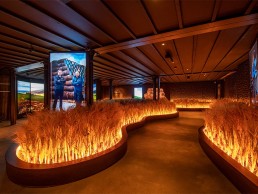Hacel Solex
The latest generation of compact downlighters, designed and manufactured in the UK by Hacel, the Solex range seamlessly combines outstanding photometric performance, with ease of installation. Delivering lumen outputs up to 5342lm and efficacies of 153lm/W. Solex is available in a wide choice of high quality control gear, including Casambi wireless lighting control. Surface and pendant options complete the Solex range.
John Cullen Lighting Contour Edge
Create clean consistent wall grazing effects with the new Contour Edge from John Cullen Lighting. It combines ultra-low glare with a high 98 CRI to suit your projects whether inside or out. The Contour Edge is available in four sizes – 25, 50, 75 and 100 – which can be easily paired together when a longer illuminated run is required, ensuring that the LED pitch is maintained for a continuous graze.
Corporate Friends C1-mini-C
The new C1-mini-C is one of the smallest Casambi Ready spotlights on the market. With its dimensions of only 42x49x17mm reduced to the absolute minimum it is especially suitable for smallest lighting solutions, where the light source must be discrete without limiting its function. The dimming range has 810 steps, from 100% to 0%, with a minimum non-zero value of 0.4%. Fitted on magnetic track (11x7mm) for 9-24V DC connection, it can be positioned freely in any direction.
Lucent Prospex Performance
A range of high output reflector-style downlights, in fixed and accent versions, which feature locking graduated adjustment to 35 and full 358 lockable rotation.
Available in four sizes – 105, 140, 160 and 195mm diameter – with delivered lumen outputs from 1800lm to 8200lm with minimal trims and a low glare 40 cut-off with semi-specular silver reflectors. Typical applications range from residence, offices and retail for the smaller size downlight, through to shopping centres and airports for the largest version.
Landscape Forms Profile
The Profile family of lights creates beautiful and intentional light emanating from a refined, minimalist design. Shadows from Profile’s I-beam channels and modular column design build a light experience like no other, creating poetry between the sculptural form and the play of light upon the object and its surroundings. One product family composed of an area light, accent light, column light, and trio of bollards.
www.landscapeforms.com/lighting
Reggiani Yori IP66
The Yori projectors family has widened with the Yori IP66 – the newest system of projects for outdoor lighting. Selected materials, IP66-rating and CRI>90 make Yori IP66 a reliable system for outdoor high-end lighting projects. Available in two different dimensions – Ø45 and Ø60 – and 10 colour finishes, its precision lenses offer quality distribution of light and smooth edge beams in line with standard Yori optics. A wide selection of accessories helps to beautifully integrate the product range into any project, from ground spikes and beam clamps to surface/pendant and wall versions.
Mawa Design seventies 70's plus contour
Creating precise lighting accents in museums: the lenses and slides of Mawa’s seventies 70’s plus contour spotlight focus light on artwork while letting it appear crisply lit from within. The seamlessly adjustable focussing lens sharply defines the artwork’s frame while the four contour slides determine the shape and size of the lighting surface. The suitability for museum use has been tested and approved by an independent research institute.
Clear Lighting Flexglo F2222
Accentuate your architectural-grade lighting with enhanced lux levels that complement the aesthetics of your space with a DMX controller that seamlessly transitions from white to RGB.
ClearTech TwinFlex and PinBoost ensure the longevity of the product’s robustness and maintenance-free features. A Combination of the silicone body and C-Mask offers protection against UV. The connector can be assembled in the factory or field, paired with InsulFit and DryWire that activate the IP68 to revolutionise a wide range of applications.
LightGraphix LD1094
LD1094 is an IP67-rated, high-power, adjustable downlight, designed for harsh exterior projects and delivering up to 755lm. It promises quick and easy on-site focusing through removal of the bezel, while installed in the mounting surface. As well as providing the ability to interchange optics, with the help of LightGraphix’s hand tool, the innovative ball joint containing the LED and optics can be rotated 360° and tilted up to 25°.
L&L Luce&Light Berica S
Berica S, the new suspended fixture from L&L Luce&Light, is defined by a minimalist design and contemporary style. Thanks to the option of elliptical optics, it’s an ideal choice for retail, offices and hospitality sectors. Available in three sizes – 620mm, 1180mm and 1740mm – and three different styles of cover – convex, concave and flat – the lamp has a double-beam output, emitting light both downards and upwards, providing a comfortable, uniform illumination. The range uses light sources with a colour temperature of 2700-4000K and a high CRI of >90.
BIO4, Denmark
Speirs Major and Gottlieb Paludan Architects have collaborated to create a wondrous façade for Copenhagen’s BIO4 biomass-fired power station.
As part of Copenhagen’s drive to become the world’s first CO2-neutral capital by 2025, local utility company HOFOR has drawn attention to its transition to sustainable energy with a bold and dynamic intervention of architecture and light at its new biomass-fired CHP power unit, BIO4.
Situated on the site of the original Amagervæket power station, the plant has undergone several upgrades since it was first constructed in 1971, eliminating the production of harmful emissions and ensuring that it is not an eyesore to nearby residents.
Completed in October 2021, the new project was spearheaded by Gottlieb Paludan Architects and Speirs Major, who won a design competition in 2014 with a concept that uses dynamic light to activate a unique ‘Forest Façade’. This six-metre-deep façade is adorned with a fascia of suspended tree trunks, creating the appearance of a dense forest. A clear visual signifier of the unit’s use and its move away from fossil fuels, the façade also plays an important role in engaging the local community and helping to embed the building into the wider identity of Copenhagen as a city.
Jesper Ravn, Architect and Lighting Designer at Gottlieb Paludan Architects, said of the initial design concept: “The story we wanted to tell was a story about wood, and giving the citizens of Copenhagen a relationship and connection to where their heating comes from.”
Keith Bradshaw, Senior Partner at Speirs Major, added: “What is very clever about the way the façade was designed, and the access in through the façade, is that it remembers to connect people to this huge, oversized, industrial facility. You don’t realise quite how big it is until you stand near it, and you certainly don’t realise how awesome it is until you stand within it. Allowing people to understand the scale of the project is something that was really ambitious, yet simple, but for me that is the nature of relating to a forest; as you walk towards it you realise that it’s much bigger and more sophisticated and complicated and layered than you might have imagined from the outside.”
Given the scale of the building and its prominent location, just two kilometres from downtown Copenhagen, its architectural expression and visual identity was also crucial. By day, the unique, organic wooden cladding system, mounted in a galvanised support structure, helps to soften the lines of the vast building while adding a sense of nuance and texture.
After dark, Speirs Major designed the visual image to be strong, yet subtle, managing the light intensity so that the façade would sit comfortably within the city context. The projected light creates a beautiful, dappled effect, gently revealing the depth and texture of the façade, while the kinetic animation celebrates the building as a source of heat for the city.
Bradshaw continued: “We went through several ideas about whether the fixtures and the light should be in the façade or projected onto the façade, and where we ended up was, in really simple terms, a very large-scale impact created with as minimal energy as possible.
“It’s layered up, sometimes with three layers of light, because you need that layering to create the magic moments where you don’t realise it’s artificial light. That’s a very rare thing in the work that we do. It’s like when you go to the theatre, most people don’t look at the lights, they just look at the effect, and they either believe it or don’t believe it. Once you clear away the technical solutions and just think about the effect, that made it feel magical.”
Ravn agreed that the new façade lighting brings a feeling of magic to the building: “One of the big achievements is when you look at the light, you can’t stop looking at it. You just want to dream your way into it. It’s like looking at little ripples in the water, a field of crops in the wind; it’s very recognisable, and yet you’ve never seen anything like it. It pushes buttons in your imagination in that it looks natural and organic, and it organically brings back the thought of where the wood comes from, that it’s alive.
“Residential buildings are less than a kilometre away, they can see this from their bedroom windows, and I don’t think that they tire of it because it’s so gentle and natural. There’s a great achievement in that.”
The lighting for the façade appears in tones of warm white under normal circumstances, with a limited palette of colours for special and civic occasions provided to further boost the local community’s engagement with BIO4.
To achieve this, Speirs Major used 49 Martin Professional Exterior 1000 projectors, while 150 DALI controlled lights from the likes of iGuzzini, Stoane Lighting, LightGraphix and Vexica are used for downlighting, linear stair handrails and other elements of the design.
Bradshaw explained further the components used to create the dynamic façade scheme: “It’s theatrical effects within architectural fixtures, and what is significant about it is that it is permanent, and it’s very robust,” he said.
“It is one of the most difficult environments in which you could put light fittings outside. There’s a lot of weather that comes through the harbour, so you need a fixture and an installation that can handle that. Also, because it’s an industrial facility, the detailing needed to feel appropriate for the setting. It’s a robust piece of infrastructure, but it creates a very delicate, theatrical effect.”
Although the six-metre-thick forest appears only on the main façade, the ‘forest’ thins out to a single skin of trunks along the east and west façades. While this may have been a challenge to Speirs Major, Bradshaw believes that the positioning of the light projections helps to reinforce the feeling of depth.
“While most of the fittings are on the public side of the project, we could project the light three-dimensionally around the corner, which created the layered effect that we were getting elsewhere on the main elevation. This means that the side elevation, which is only one-metre-thick, and the main elevation look like one piece. It took a lot of skill and quite a bit of luck for it to look just as beautiful as it does, as it is not just an elevation, it’s a three-dimensional object that we’ve lit. Everything about the façade is very three-dimensional – it is an abstracted, framed view of a forest that we’ve gently placed around the building. It’s a playful abstraction of what’s going on inside the building.”
Within this abstract forest of light, a staircase leads up to a viewing platform on the roof. By ascending the stairs, visitors can immerse themselves in the forest and experience the kinetic light effect from within – an experience that Bradshaw compares to entering a remarkable alternate reality.
“The journey up the staircase is really amazing because this is a civic infrastructure project, it’s not a space that you think would be easy for people to inhabit. But what is so beautiful about the architectural design and the scaling of the staircase is that as you walk through it and experience the effect of the dappling of light coming through all the layers, all the narratives of being in an enchanted forest begin to start. There is something mystical about it. There is an energy in the forest. Even though the temptation may be there for some, you don’t really want to look for where the light is coming from, you just want to experience the effect.”
The addition of a means for the public to directly interact with the building is something atypical to what one might expect for this kind of infrastructure project, but Ravn feels the move was an integral part in giving citizens of Copenhagen a connection to the power station.
“If you think of power stations from different generations, Battersea Power Station for example, that is effectively a Victorian cathedral saying ‘we love energy, we love progress’. The next generation didn’t want to build in brick, they wanted quick, efficient, hidden sites that were out of the way. But that’s not enough today,” he said. “Cities are growing, and someone will be living close to these things soon, so it’s not acceptable that we build ugly infrastructure that no one wants in their back yard. That’s why we tried to make something attractive that people can relate to and appreciate. We then took that to extremes by inviting people to come closer, to touch it and walk up the façade, which is very unusual. Our desire was to connect citizens to the reality of where we get our heat.”
Bradshaw added: “Connecting people to where their heat comes from is what underpins this entire project. The level of civic engagement and civic responsibility, pride, and knowledge is extraordinary – people care about this project, they care about where their heat comes from, and they want to know what this site is for. By being humble enough to say, ‘this is what it is, this is the reality of who we are, let’s do something special with it’, rather than pretending it doesn’t exist is very brave.
“The celebration that this power plant is a major green provider of heat for Copenhagen – it covers almost 60% of the district heating in the city – means that as we continue to engage people with issues of energy and sustainability, telling the story of what it takes to power a city, rather than hiding it away or burying it underground, we are using light to promote its lower carbon footprint.”
Since the competition stage in 2014, Speirs Major and Gottlieb Paludan Architects have been in close, constant collaboration on this project, working together to create a finished project where the architecture and lighting are seamlessly intertwined in one, cohesive narrative.
Both Bradshaw and Ravn believe that this collaboration is something that directly contributed to the success of the overall project.
Bradshaw said: “If we were making a film, Jesper was the producer, the person that really made it happen, where he kept everyone connected and focused on what this was. That would not have happened had Jesper not done it.
“People use the word collaboration all the time, but there’s another story to what good collaboration is, and it’s much rarer. We do a lot of projects, but very rarely do you come out of it with an amazing result and an amazing feeling that you have done something special. There are no doubts on this project; we were always pointing in the same direction because we had an idea that was appropriate, timeless, authentic, real, and we felt that we had to protect it for as long as possible until it was delivered. Getting down to the heart of what we aspired to do, we can say that it has been delivered beautifully.”
Ravn concluded: “I’ve always known that I could trust Speirs Major, and that they could deliver a beautiful solution. It took a long time before anything regarding the lighting got specific, we were very close to the end before we saw what this was going to look like, but by throwing words back and forth about what we feel, what it is, how we understand each other, reassured everyone.
“That is the strong link between light and architecture; I don’t think that you can separate the two. I work with both and they’re one thing – there is nothing that architecture is about that light is not also about.
“How does the light work together with the architecture? How can it bring the space to life? How can it be the visual music to the physical building? The soul in the body? The electricity in Frankenstein’s monster? How can the light be that? That’s hard, but that’s the point in bringing light and architecture together, and I think we’ve been able to do that all along.”
www.smlightarchitecture.com
www.gottliebpaludan.com
Glenlivet Visitor Experience, UK
The iconic whisky brand Glenlivet has created an immersive and interactive visitor experience at its Speyside distillery that reflects its rich heritage, high standards, and welcoming nature. A vibrant lighting scheme from Into adds to the warm and welcoming atmosphere of the space.
The Glenlivet, Speyside’s original single malt, is welcoming whisky fans to its newly refurbished home in Speyside, Scotland. After undergoing 18 months of extensive renovations, the home of The Glenlivet has become so much more than a distillery, with a new look and feel.
Following in the footsteps of its founder, George Smith, and his legendary hospitality, the redevelopment reflects his high standards and welcoming nature. Using innovative technology combined with exclusive bottlings, immersive tours, and whisky tastings, The Glenlivet brings visitors an experience like no other. From exploring the art of whisky-making and showcasing rare editions, to reflecting The Glenlivet’s heritage throughout the interiors, the new visitor experience pays homage to being the original mark of quality for Speyside single malt.
Designed by London-based studio Blacksheep, with lighting design from Into, the valley of the smooth flowing River Livet echoes throughout the visitor experience, while the interiors have been inspired by The Glenlivet Estate and the wilderness of the Cairngorms National Park, in which it sits.
Working closely with the interior designers throughout the entire project, Johanna Paice, Associate at Into talks arc through the design process: “When we first met with the interior design team, they ran through their concept for each area – their visuals had a very strong aesthetic and really helped us to get an idea of what the client would like and how the overall space would work. We discussed possible lighting ideas and solutions at this stage; for some areas, they had very strong ideas of what the lighting should be like and the effect they wanted to create, in other areas it was more of a discussion. Our concept was to make the space feel inviting and to ensure there was a balance between showing off the products and experience but still making it feel authentic to the original space and location.”
The visitor centre is spread over the ground and lower floors of the distillery. Visitors enter via the reception where they are greeted by a spectacular custom chandelier by London-based florists, Grandirosa, which is made from local dried wildflowers. From here the visitors embark on a guided explorative journey through a series of spaces that bring the story of The Glenlivet to life. Spaces that follow, include a lounge, which acts as a waiting area ahead of the tour; The Tasting Room - a dramatic circular space featuring a round custom walnut table at its centre as well as a sculptural display that rises from the table displaying a selection of whiskies; then there’s The Sample Room and The Provision Room retail spaces; The Drawing Room - an atmospheric and relaxed onsite bar; The Smugglers Hideout - an elevated private space for tasting the finest bottles of whisky; and then finally The Glenlivet Warehouse, featuring floor to ceiling whisky barrels that are illuminated with hidden linear LEDs washing down. The Warehouse space is split into three, the angel’s share showcasing the aging process of the whisky with a large backlit display, with the two other areas focusing only on the areas of interest making the space feel moody and interesting.
Initially, Into focused on each area of the Experience separately, reviewing the integral details via mock-ups to ensure they worked with the finishes suggested. The team then added layers of light to the space to enhance Blacksheep’s interior design. “Every fitting was reviewed and colour temperatures throughout the space were considered to get the best effect possible,” said Paice. Final fixtures for the project were selected from: KKDC, Engima, UFO, LightGraphix, Stoane Lighting, TM lighting, Hunza, Lightform, Lite-house, and Soraa.
Into used clever lighting design to differentiate the various spaces while ensuring they were seamlessly linked. “We wanted the space to feel harmonious, but the individual areas also needed to stand out in their own right, especially the retail spaces,” Paice explained. “Lighting was used to zone the areas with dimming to each; we also used colour temperature to denote different areas. The retail spaces were slightly cooler with 2700K light fittings, this also helped highlight the true colour of the whisky. Whereas the Experience area was a lot warmer with 2200K fittings.
“Showcasing the products was one of the main focuses of the lighting scheme,” Paice continued. “This was done with integral lighting details mounted within the joinery and I think this helped to get the balance between showcasing the products and staying true to the concept and the homely feel of the ground floor space. It helped that the interior finishes were naturally warm, with lots of rich colours and woods used. The whiskey itself is such a lovely amber colour that highlighting this with warmer light helped to really bring the bottle to life.
“The tasting room was slightly different to the other spaces, while it was still very dramatic as you walk in, the lighting was more visual with large circular suspended profile rings mounted at high level and used as a feature. They were dimmed very low instead of using them to light the space. We also highlighted the bottles within the display using light sheets hidden within each bespoke shelf. As the visitors taste each one, the shelves with the whisky they are tasting illuminates.”
The main theatrical elements throughout the space are within the lower ground floor experience and as guests walk into the Speyside room filled with barley, the architectural lighting is used to create drama within the space. “We wanted to bring the barley to life and make sure it didn’t get lost,” continued Paice. “This was done with fibre optic pavers mounted within the base of the barley shining up and through. The light shimmers and moves to create the effect of barley moving in the wind.
“The rest of the lighting in the space is focused, with dramatic pools of light on the floor and uplighting details to the carved wood walls to add depth and layering the space.”
For Paice, as there are so many beautiful handmade displays and finishes within this project, highlighting them in a sensitive way became even more important. “Lighting also helped to create unusual effects and make the space feel more impactful and dramatic,” she said. “We are really happy with the overall lighting design. It’s very close to what was originally discussed at the concept stage with the only differences occurring because of the various mock-ups, which identified the best execution of each lighting detail. Not only did these demonstrate to the client possible ways to present their product, but they also steered the collaboration between lighting and joinery, which was a great success.”
Darren Orrow, Director at Into, added: “This was such a fantastic project to work on; both the interior designer and client had some great ideas for lighting. We all worked very closely on mock-ups and detailing to make sure our collective creative vision could be realised within budgets and timescales.”
Commenting on the finished product, Miriam Eceolaza, Director of The Glenlivet, said: “After 18 months of renovations, we can’t wait to open the doors to our local communities and bring whisky lovers into our new visitor experience. It’s a true immersion into the iconic Speyside region, walking guests through our stunning indoor field of local barley, tasting from our old and rare archives, experimenting with our famous cocktail capsules and taking a unique piece of Speyside home with our straight from the cask personalised bottling. From the decor and design to ambience and atmosphere, guests will witness something truly original at every turn.”


